Johnny Cappone
Hazard to Self
 
Posts: 74
Registered: 10-12-2020
Location: Brazil
Member Is Offline
|
|
Homemade Gas Burner - The poorman's Bunsen Burner
Today I published a video where I narrate the construction of what I call "a homemade bunsen burner for outdoor use".
(https://youtu.be/TBGOinVqCBU)
My alcohol lamp served me for a long time. It was possible to do almost anything with it, including melting small portions of lead or concentrating
small volumes of sulfuric acid.
However, I felt the need for an apparatus in which it was possible to adjust the heating in a more comfortable way. This project fills this gap.
I know that a decent gas burner is not terribly expensive, but sometimes a not-so-young financially fucked chemist needs to be glad with the few
resources he can devote to his hobby. Also, building things and seeing them work is always fun.

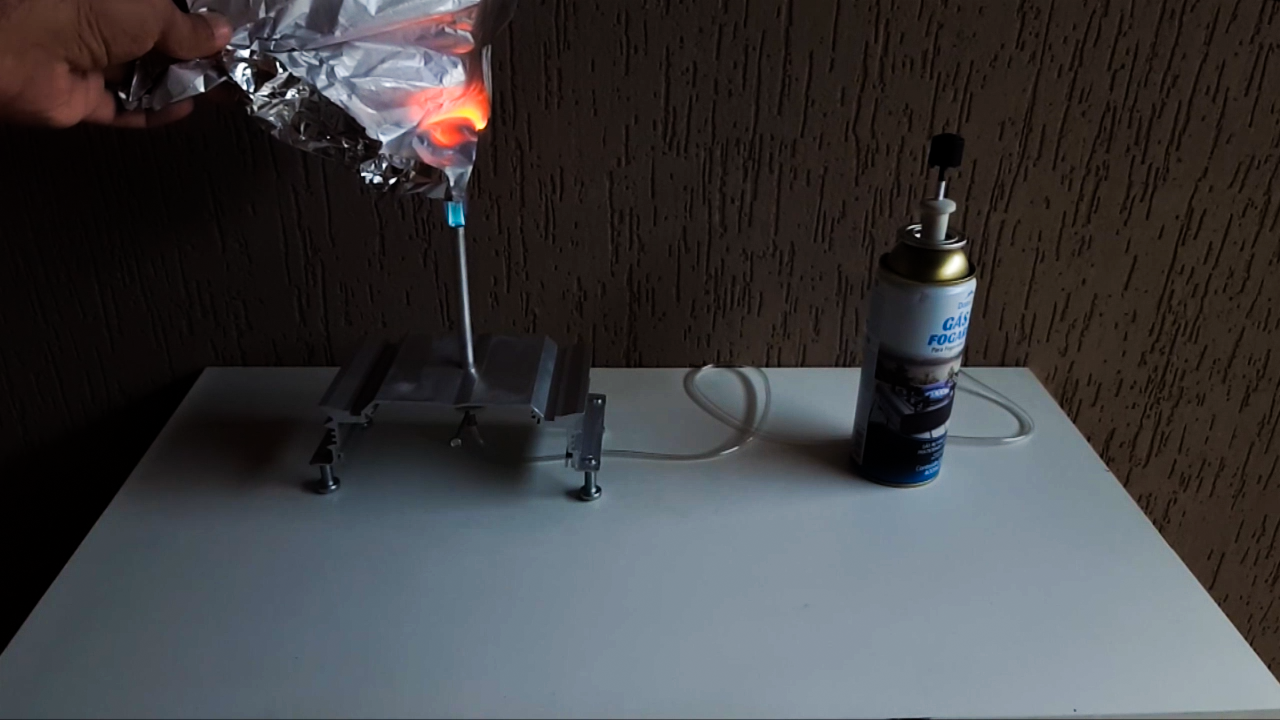

I thought that the air regulator, being made of plastic, would be one of the critical parts of this project. However, I found that:
1) The flame does not appear to burn inside the tube or even at the open end of it, there appears to be a millimeter interface between the lower end
of the flame and the gas flow at the outlet of the tube. That is, the flame front does not seem to hit the metal at any time, but rather to burn a
millimeter or less just above it. It is possible that this is a characteristic of this specific system and the low gas injection pressures involved.
2) The gas leaves the cylinder at a really low temperature and cannot exchange heat with the ambient before reaching the burner. In fact, in some
moments, even in full operation, it is possible to feel the bottom of the aluminum tube slightly cold
3) The use of a heatsink as a base was really efficient in removing any residual heat before it reached the regulator.
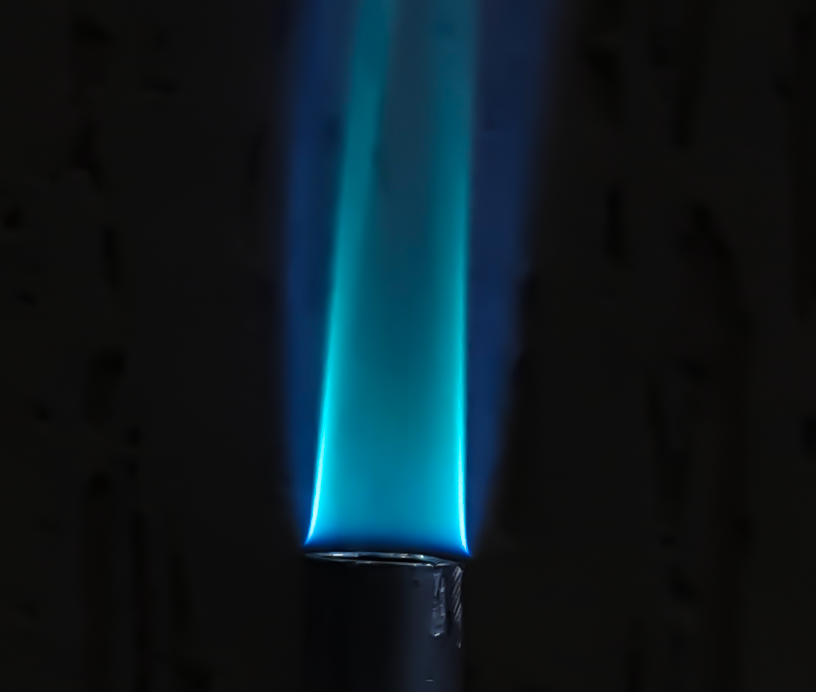
The gas regulator is a point that deserves continuous attention. It worked incredibly well and tests carried out under water proved that there were no
leaks of any kind. However, it is still a homemade regulator being used to extract flammable gas from a pressurized cylinder. Since the device will be
used exclusively outdoors, small leaks of gas at the regulator junctions - more dangerous for this poor chemist's wallet than for his safety, I would
say - can be induced by the vibrations of daily use. I intend to replace it with a suitable regulator as soon as possible.
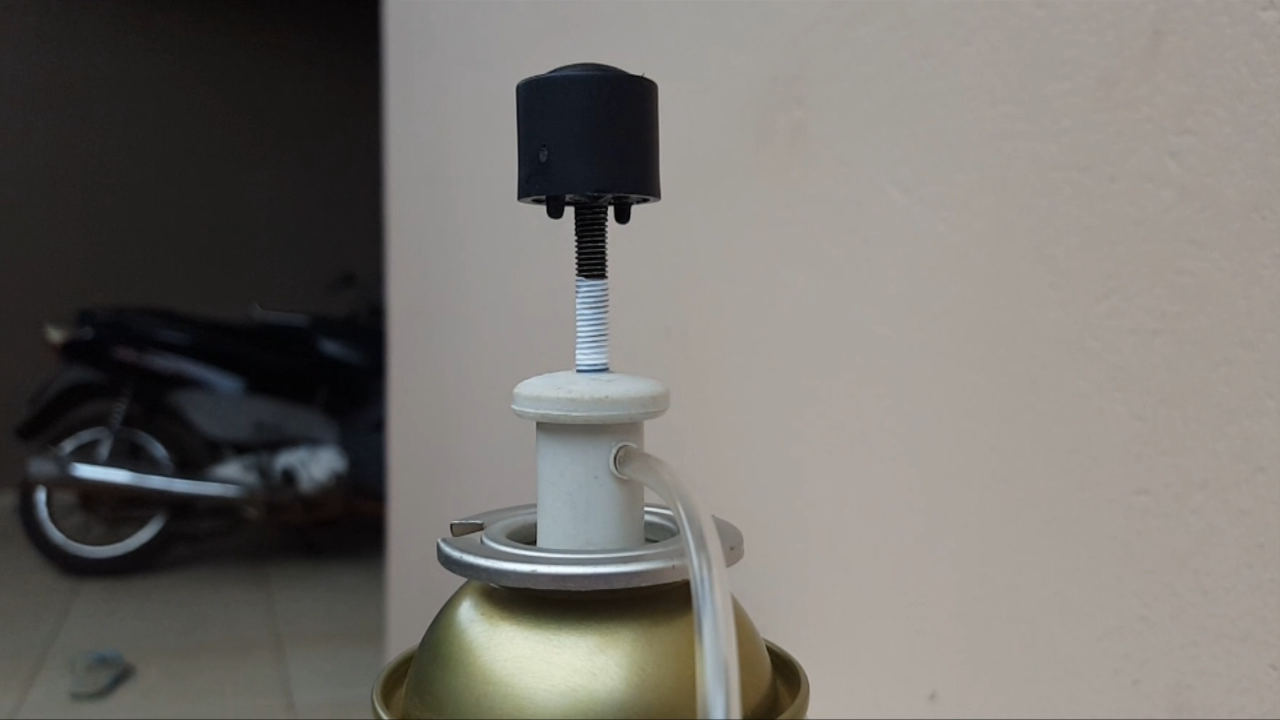
Having said all that, I am happy for my new equipment. Heating things up to moderate temperatures will become a little easier now 
[Edited on 31-3-2021 by Johnny Cappone]
|
|
|
paulll
Hazard to Self
 
Posts: 99
Registered: 1-5-2018
Member Is Offline
Mood: It's fine. Really.
|
|
Nicely done!
|
|
|
itsallgoodjames
Hazard to Others
  
Posts: 276
Registered: 31-8-2020
Location: America Lite
Member Is Offline
|
|
Cool! Kind of unrelated, but those are some huge images.
Nuclear physics is neat. It's a shame it's so regulated...
Now that I think about it, that's probably a good thing. Still annoying though.
|
|
|
Johnny Cappone
Hazard to Self
 
Posts: 74
Registered: 10-12-2020
Location: Brazil
Member Is Offline
|
|
I swear to God I don't know how it happened.
I always take care to resize the images to a suitable size before posting them on forums, for some bizarre reason these have gotten so big that they
distorted the text box. Selecting the "print version" option helps a little.
Edit: I found that it is possible to use the command [img = 50x50] http://www.php.net/gifs/example_example.gif [/ img] to resize the posted images regardless of their resolution on the original site. My bad for
the gigantic images.
Despite having been lurking for about 10 years, I am still learning how to use the forum tools 
[Edited on 31-3-2021 by Johnny Cappone]
|
|
|
itsallgoodjames
Hazard to Others
  
Posts: 276
Registered: 31-8-2020
Location: America Lite
Member Is Offline
|
|
Quote: Originally posted by Johnny Cappone  |
I swear to God I don't know how it happened.
I always take care to resize the images to a suitable size before posting them on forums, for some bizarre reason these have gotten so big that they
distorted the text box. Selecting the "print version" option helps a little.
Edit: I found that it is possible to use the command [img = 50x50] http://www.php.net/gifs/example_example.gif [/ img] to resize the posted images regardless of their resolution on the original site. My bad for
the gigantic images.
Despite having been lurking for about 10 years, I am still learning how to use the forum tools 
[Edited on 31-3-2021 by Johnny Cappone] |
I'm not sure if it's just me, but all the images seem to be broken now. None of them show up anymore for some reason
Nuclear physics is neat. It's a shame it's so regulated...
Now that I think about it, that's probably a good thing. Still annoying though.
|
|
|
Triflic Acid
Hazard to Others
  
Posts: 486
Registered: 27-9-2020
Member Is Offline
Mood: Slowly Oxidizing into Oblivion
|
|
I think it is just you James, since I can see it just fine.
There wasn't a fire, we just had an uncontrolled rapid oxidation event at the power plant.
|
|
|
Bedlasky
International Hazard
    
Posts: 1219
Registered: 15-4-2019
Location: Period 5, group 6
Member Is Offline
Mood: Volatile
|
|
Very nice!
|
|
|
draculic acid69
International Hazard
    
Posts: 1371
Registered: 2-8-2018
Member Is Offline
|
|
Nicely done.
Could you tell us more about where U got the parts or off what products U got them plz. A parts list would be great.
For example what is the white thing the regulator is made of? And is that black
Screw thing a metric fine threaded long thin bolt? Does it just thread through the white regulator part?
[Edited on 1-4-2021 by draculic acid69]
|
|
|
Johnny Cappone
Hazard to Self
 
Posts: 74
Registered: 10-12-2020
Location: Brazil
Member Is Offline
|
|
Quote: Originally posted by draculic acid69  | Nicely done.
Could you tell us more about where U got the parts or off what products U got them plz. A parts list would be great.
For example what is the white thing the regulator is made of? And is that black
Screw thing a metric fine threaded long thin bolt? Does it just thread through the white regulator part?
[Edited on 1-4-2021 by draculic acid69] |
Sure! Most of the stuff was scrap that I keep in an old chest.
When we are going to discard something (an empty shampoo bottle, a jar of mayonnaise, an old microwave) I look at that and ask myself, "Is there
anything I can use to build something interesting?"
When building something improvised, I simply open my old chest and see which pieces can fit together to fulfill the desired purpose. That is why,
instead of having a list of parts that could be purchased, there is a visual description of each component and its function.
Both regulators were made with "finishing hole plugs" (I think that is the correct term) obtained from a fruit bowl that would go to waste, but they
could perfectly be made with plastic billets and a drill.
The gas regulator screw is, as you noted, just a long, thin screw that has been covered with plumber's tape (PTFE). There is nothing special about it,
except that it must have a fine thread and fit firmly on the plastic part that covers the gas valve. When turned clockwise it moves down and presses
the valve to release the gas. The fact that it has a fine thread allows it to move in small increments with each turn, which allows fine control of
the gas flow.
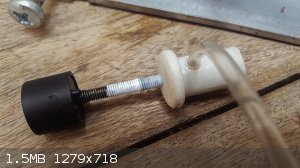 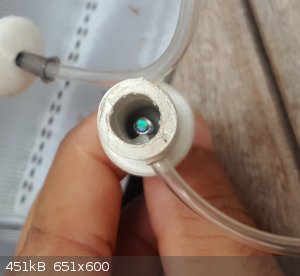
|
|
|
MadHatter
International Hazard
    
Posts: 1332
Registered: 9-7-2004
Location: Maine
Member Is Offline
Mood: Enjoying retirement
|
|
Format Factory
https://format-factory.en.softonic.com
Johnny, above is a link that might be able to
help you trim files. Technically it's conversion
software. I've used it to make program icons
from jpeg images. It's ad supported so there
is no cost. This free tool has been very useful.
BTW, nice job on your burner. You did what
most financially limited scientists do. Adapt
existing materials on hand.
From opening of NCIS New Orleans - It goes a BOOM ! BOOM ! BOOM ! MUHAHAHAHAHAHAHA !
|
|
|
draculic acid69
International Hazard
    
Posts: 1371
Registered: 2-8-2018
Member Is Offline
|
|
As for the using random scraps of stuff I also do the same and have a toolbox full of the same sort of stuff your talking about. Little pieces of
stuff U pick up here and there are what U need to join this to that and make things work. I thought the white regulator part was off a poptop bottle
or something.
|
|
|
Johnny Cappone
Hazard to Self
 
Posts: 74
Registered: 10-12-2020
Location: Brazil
Member Is Offline
|
|
Thanks for the suggestion, MadHatter! In fact, I use Adobe Photoshop to do this kind of work. The problem of the giant images had already been
solved, it was just a detail in the HTML code that I used to embed the images in the post.
|
|
|
earpain
Hazard to Others
  
Posts: 102
Registered: 11-9-2019
Member Is Offline
|
|
I make torches too
Thank you for sharing!
So that is butane or propane?
Do you have a pressurization orifice , in the gas supply somewhere, as any plumber's torch etc. would have? If so, did you make it or gut it from
something else? (the store bought ones have a bored hole that is too small to be visible to the naked eye)
Also, I could be wrong here, but I think there may be a technical difference between a 'regulator' vs, a 'valve'. I built a big torch connecting to
a BBQ size large propane tank. I used a proper regulator(designed for acetylene), a regulator+valve i cannabilized from a plumber's torch, and then I
tried just a needle valve. My understanding is that a regulator vs. valve is like thermostat vs. voltage/flame size control. Taking the regulator
apart revealed a different mechanism for controlling the gas flow then a needle valve, which I believe is the same as your fine threaded lug device.
Where as a regulator would have a diaphragm like rubber piece, and a spring, and would increase flow when screwing in, vs. a valve increases the gas
when unscrewing.
If the flame is igniting above the opening of the burner, this usually indicates less-than-ideal fuel:O2 mixture. Even when the source of O2 is
simply from the ambient atmosphere. Adding an elbow at that spot would allows the oxygen and fuel to mix up a bit more before burning. Otherwise
steal wire screen, or something similar helps dramatically.
At some point i will rebuild my performance CPU fan powered forced air burner and post pictures. I used 3/4in diameter steel pipes for most of the
body, and part of a telescope for the torchhead.
How hot does the heat sink get?
Thanks again for sharing!
|
|
|
Johnny Cappone
Hazard to Self
 
Posts: 74
Registered: 10-12-2020
Location: Brazil
Member Is Offline
|
|
Quote: Originally posted by earpain  | Thank you for sharing!
So that is butane or propane?
Do you have a pressurization orifice , in the gas supply somewhere, as any plumber's torch etc. would have? If so, did you make it or gut it from
something else? (the store bought ones have a bored hole that is too small to be visible to the naked eye)
Also, I could be wrong here, but I think there may be a technical difference between a 'regulator' vs, a 'valve'. I built a big torch connecting to
a BBQ size large propane tank. I used a proper regulator(designed for acetylene), a regulator+valve i cannabilized from a plumber's torch, and then I
tried just a needle valve. My understanding is that a regulator vs. valve is like thermostat vs. voltage/flame size control. Taking the regulator
apart revealed a different mechanism for controlling the gas flow then a needle valve, which I believe is the same as your fine threaded lug device.
Where as a regulator would have a diaphragm like rubber piece, and a spring, and would increase flow when screwing in, vs. a valve increases the gas
when unscrewing.
If the flame is igniting above the opening of the burner, this usually indicates less-than-ideal fuel:O2 mixture. Even when the source of O2 is
simply from the ambient atmosphere. Adding an elbow at that spot would allows the oxygen and fuel to mix up a bit more before burning. Otherwise
steal wire screen, or something similar helps dramatically.
At some point i will rebuild my performance CPU fan powered forced air burner and post pictures. I used 3/4in diameter steel pipes for most of the
body, and part of a telescope for the torchhead.
How hot does the heat sink get?
Thanks again for sharing!
|
Thanks for the comments!
1) according to the label, the gas contained in the cylinder is a mixture of butane and propane. No information is provided about the exact
proportions.
2) I used a hypodermic needle at one end of the gas line to create a choke, you can see it between the materials at the beginning of the video and in
more detail along it.
3) The heat sink is incredibly underheated compared to all the heat that is produced by the flame just above it. I did a long test (> 45 minutes)
and at the end it was just warm to the touch.
Let us know as soon as your burner is ready!
I saw many amazing gas burner designs on YouTube, my portable bunsen burner is just an inexpensive design that met my needs. As I found some creative
solutions throughout the project, I decided to share its construction. I want to work on more powerful burners in the future, this opens up the
possibility of carrying out several interesting reactions that require high temperature (in addition to opening the doors to metallurgy, a hobby
shared by many here, I believe).
|
|
|
earpain
Hazard to Others
  
Posts: 102
Registered: 11-9-2019
Member Is Offline
|
|
Quote: Originally posted by Johnny Cappone  | Quote: Originally posted by earpain  | Thank you for sharing!
So that is butane or propane?
Do you have a pressurization orifice , in the gas supply somewhere, as any plumber's torch etc. would have? If so, did you make it or gut it from
something else? (the store bought ones have a bored hole that is too small to be visible to the naked eye)
Also, I could be wrong here, but I think there may be a technical difference between a 'regulator' vs, a 'valve'. I built a big torch connecting to
a BBQ size large propane tank. I used a proper regulator(designed for acetylene), a regulator+valve i cannabilized from a plumber's torch, and then I
tried just a needle valve. My understanding is that a regulator vs. valve is like thermostat vs. voltage/flame size control. Taking the regulator
apart revealed a different mechanism for controlling the gas flow then a needle valve, which I believe is the same as your fine threaded lug device.
Where as a regulator would have a diaphragm like rubber piece, and a spring, and would increase flow when screwing in, vs. a valve increases the gas
when unscrewing.
If the flame is igniting above the opening of the burner, this usually indicates less-than-ideal fuel:O2 mixture. Even when the source of O2 is
simply from the ambient atmosphere. Adding an elbow at that spot would allows the oxygen and fuel to mix up a bit more before burning. Otherwise
steal wire screen, or something similar helps dramatically.
At some point i will rebuild my performance CPU fan powered forced air burner and post pictures. I used 3/4in diameter steel pipes for most of the
body, and part of a telescope for the torchhead.
How hot does the heat sink get?
Thanks again for sharing!
|
Thanks for the comments!
1) according to the label, the gas contained in the cylinder is a mixture of butane and propane. No information is provided about the exact
proportions.
2) I used a hypodermic needle at one end of the gas line to create a choke, you can see it between the materials at the beginning of the video and in
more detail along it.
3) The heat sink is incredibly underheated compared to all the heat that is produced by the flame just above it. I did a long test (> 45 minutes)
and at the end it was just warm to the touch.
Let us know as soon as your burner is ready!
I saw many amazing gas burner designs on YouTube, my portable bunsen burner is just an inexpensive design that met my needs. As I found some creative
solutions throughout the project, I decided to share its construction. I want to work on more powerful burners in the future, this opens up the
possibility of carrying out several interesting reactions that require high temperature (in addition to opening the doors to metallurgy, a hobby
shared by many here, I believe).
|
1) I ask because you mentioned concern about leaks. The only one of these simple alkane gasses that I have ever encountered to NOT have a smell
indicator added, is butane. And that is only for the smaller containers intended only for small lighters. Leaks are definitely a problem that should
be fixed, but in my experience it's not a life/death problem. The only danger from a poisonous gas occurs when using oxy/acetylene or oxy/propane, as
in glassblowers torches or metal cutting torches, and poor ventilation, has set off my CO detector before.
Maybe once or twice on a very small device a leak ignited. But since there is absolutely no oxygen yet at the spot where the leak ignites, it just
creates a quick fuel rich flame, like from a cigarette lighter, and then the compressed gas blows it out. Not good. Someone with long hair for
example, maybe would be in danger. But it doesn't explode.
So smell indicator has sufficed for me for this purpose. Other options are as you mention water, soapy water is often used, but more often for things
like car tires etc.
And then of course the lovely UV leak indicator. I have yet to try this but I'm sure it's as wonderful as people say.
2) oops! sorry I'll watch the video. Hypodermic needle is a great solution
3) I'm not surprised. I would welcome an experts critique on this, but I don't think burners and torches with compressed gas send heat backwards
towards the gas tank. Yes the metal torchhead of course gets hot. But any part of the the torch leading up to there, has a gas blowing through it.
Also likely has atmospheric air being sucked in via the vacuum created by the venturi effect thanks to the orifice. And to really seal the deal, the
gas is being decompressed, which is profoundly endothermic as you pointed out when you mentioned parts feeling cold. If this were coal or wood or
something like that burning, none of this would apply.
Yes reactions, metallurgy, and I think some members may share my particular interest...glass blowing!

|
|
|
Morgan
International Hazard
    
Posts: 1660
Registered: 28-12-2010
Member Is Offline
Mood: No Mood
|
|
I was reading about the Irish physicist John Tyndall and a steatite or soapstone burner used from the 1800's. Maybe there's some ideas or interest in
designs/history from those early days.
"As can be appreciated, the amount of steatite dust or powder that was turned and cut off the thousands of parts was considerable. William, in classic
style – and in much the same way as waste from cereal production is turned into compressed biscuits – came up with an extraordinary product. By
compressing the steatite powder into metal tins he was able to offer a product that was called “Pearly Queen Tooth Powder”! Clearly abrasive, I
suspect that it worked extremely well but I would also suspect that too much brushing could well remove not only the tartar but also the enamel!"
https://williamsugghistory.co.uk/lighting/burners/open-flame...
|
|
|
Johnny Cappone
Hazard to Self
 
Posts: 74
Registered: 10-12-2020
Location: Brazil
Member Is Offline
|
|
@Earpain
The gas I'm using has practically no smell, just a very light aroma that clearly resembles cooking gas. I know they add ethanethiol to LPG to alert
you to leaks. My only concern with the possibility of leaks stems from the fact that I built my own valve/regulator, although, before use, I always
check the connections with foam and haven't found any leaks until now.
Yes, these cylinders are so small that there is simply no useful area for the gas to exchange heat with the walls of the container at an appreciable
level. This exchange ends up happening in the hose that conducts the gas and, eventually, in the body of the burner. And as the fuel/oxidizer is mixed
by the Venturi effect, certainly the air swallowed by the instrument also has an effect on cooling.
Dude, learning to blow glass is something I would love to do! In fact, I think that in the Scimad library there is some interesting literature on
this available.
@Morgan: Interesting reading, thanks for the link!
|
|
|
earpain
Hazard to Others
  
Posts: 102
Registered: 11-9-2019
Member Is Offline
|
|
Quote: Originally posted by Johnny Cappone  | @Earpain
The gas I'm using has practically no smell, just a very light aroma that clearly resembles cooking gas. I know they add ethanethiol to LPG to alert
you to leaks. My only concern with the possibility of leaks stems from the fact that I built my own valve/regulator, although, before use, I always
check the connections with foam and haven't found any leaks until now.
Yes, these cylinders are so small that there is simply no useful area for the gas to exchange heat with the walls of the container at an appreciable
level. This exchange ends up happening in the hose that conducts the gas and, eventually, in the body of the burner. And as the fuel/oxidizer is mixed
by the Venturi effect, certainly the air swallowed by the instrument also has an effect on cooling.
Dude, learning to blow glass is something I would love to do! In fact, I think that in the Scimad library there is some interesting literature on
this available.
@Morgan: Interesting reading, thanks for the link! |
I was told that household methane has something added to it that is derived from onions. Could be region specific. Well, I would suggest switching
to a different product of compressed combustible gas, that does have the terrible smell added(propane and 'MAPP' seem to hit a rotten egg - dead
animal sort of note), merely to save yourself the trouble of checking using soapy water.
And yes! Those are good reads in the library. On facebook there's a large group called Torchtalk, and they're all glass blowers. Although few
scientific ones, they do pop up sometimes with great info. Also a few known members here.
Up-to-date information on the craft is bit shrouded. Sometimes one must resort to youtube.
Cheers!
|
|
|